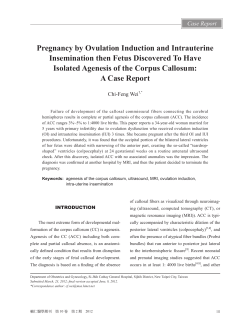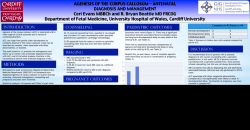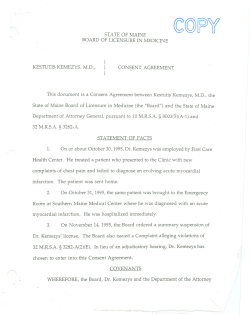
Agenesis and Dysgenesis of the Corpus Callosum Information Sheet Definition:
Agenesis and Dysgenesis of the Corpus Callosum Information Sheet Definition: Agenesis (absence) and dysgenesis (malformation) of the corpus callosum are brain abnormalities involving the large bundle of nerve fibers that connect the two hemispheres of the brain (the corpus callosum). These fibers may be completely absent, partially absent, thin, or malformed in some way. Although a callosal condition can occur as an isolated diagnosis, it is often associated with other physical, medical, or genetic conditions. The corpus callosum is important for processing and integrating sensory, motor, and cognitive information. When the corpus callosum is missing or malformed, these functions may be affected. The impact can range from subtle to severe, often depending on additional conditions that may also be present in the individual. Researchers are working to better understand the impact of these disorders and the similarities and differences among and between the different types. Common Terms: • • • • • • • ACC (Agenesis of corpus callosum): all or a portion of the corpus callosum is absent AgCC (Agenesis of corpus callosum): another abbreviation sometimes used for ACC c-ACC (Complete agenesis of the corpus callosum): the entire corpus callosum is absent p-ACC (Partial agenesis of corpus callosum): a portion of the corpus callosum is absent Dysgenesis of corpus callosum: the corpus callosum is present, but malformed in some way Hypogenesis of the corpus callosum: another term used to describe p-ACC Hypoplasia of corpus callosum: the corpus callosum is present but abnormally thin Incidence: It is unclear how often disorders of the corpus callosum actually occur since no one knows how many individuals have callosal conditions but are not diagnosed. Current research suggests callosal conditions may occur in as many as 4 persons per 1,000 in the general population. They occur more frequently among persons with developmental disabilities (22-24 per 1,000). Diagnosis: Abnormalities of the corpus callosum can be diagnosed by computerized tomography (CT) scan or magnetic resonance imaging (MRI). They are sometimes detected during pregnancy through routine prenatal ultrasound. When detected prenatally, a CT scan or MRI is often ordered to confirm the diagnosis and obtain additional information. Cause: It is often difficult to determine the precise cause of the callosal abnormality, although medical testing, including genetic testing, can sometimes provide valuable information to families. Potential causes include chromosome errors or inherited genetic factors, prenatal infections, injuries, or toxic exposures, structural blockages (e.g. cysts), metabolic disorders, or other unknown factors. Associated Conditions: Individuals who have a callosal disorder as an isolated condition may be physically healthy and have typical intelligence with subtle, yet significant, cognitive effects. Others have additional brain This information is intended for educational purposes only. Please consult your healthcare professionals for diagnosis and treatment. This information reflects the current status of research and knowledge at the time of production (3/2/08) and is subject to change as new research findings emerge. Produced by: ACC Network, University of Maine 5749 Merrill Hall, Orono, Maine 04469 -5749 www.umaine.edu/edhd/research/accnetwork.htm Phone: 207-581-3119 Email: um-acc@umit.maine.edu abnormalities or physical or medical conditions that also affect health and development to varying degrees. These additional conditions may include: • • • • • Seizures Abnormal head and facial features Brain anomalies (e.g. hydrocephalus, Arnold-chiari malformation, or migration disorders) Syndromes (e.g. Aicardi or Andermann) Other genetic disorders • • Cognitive impairments (e.g. mental retardation and/or learning disorders) Behavioral disorders such as attention deficit disorder (ADD), attention deficit hyperactivity disorder (ADHD), obsessive/compulsive disorder (OCD), autism or autistic-like behaviors More rarely, abnormalities that affect other bodily systems, such as genito-urinary or gastro-intestinal defects, cardiac anomalies, skeletal defects, or metabolic disorders may occur. Characteristics: The following characteristics are reported more commonly in individuals with callosal disorders, and an individual with a callosal condition may have few or many of them. • • • • • • • • Generally happy, pleasant disposition, enjoys being with others Developmental delays (e.g. late to crawl, walk, or talk, toilet training) Sensory issues (e.g. visual impairments, hearing deficits, increased sensitivity to touch) Low muscle tone Clumsiness/poor motor coordination Feeding/eating difficulties, gastric reflux High tolerance to pain Sleep-related difficulties (e.g. getting to sleep, nighttime waking, bed-wetting) • • • • • • Difficulties maintaining attention; restlessness or hyperactivity Difficulty with complex tasks, abstract reasoning and problem solving Difficulty imagining the consequences of their own behavior Socially immature, lacks selfawareness, may have difficulties with peer relationships Very concrete in thought processes, difficulty with slang, sarcasm or sophisticated humor Difficulty understanding social cues and expectations Treatment: Callosal disorders are lifelong conditions. Individuals can benefit from early intervention services, supportive therapies, special education, and adult support services based on their individual needs. Evaluations and therapies should begin early in life and continue throughout childhood and into adult life. As researchers continue to learn more about the causes and impact of callosal conditions, families and professionals may gain additional knowledge to improve interventions and supports. For more information, contact: ACC Network 5749 Merrill Hall Room 337 University of Maine Orono, ME 04469-5749 USA (207) 581-3119 Email: um-acc@umit.maine.edu www.umaine.edu/edhd/research/accnetwork.htm Readers are encouraged to copy and share this handout, but please credit the ACC Network.
© Copyright 2025





















